Bill Nelson NASA長官の京都大学での講演会 NASA Administrator Bill Nelson visits Kyoto University
2023年2月11日、京都大学にて開催されました、Bill Nelson NASA長官との交流会について、当日の講演の内容を以下に記載しましたので、当日参加された方、また参加できなかった方もぜひご覧ください。
The following is a transcription of the speech and interview with NASA Administrator Bill Nelson, held at Kyoto University on February 11, 2023.
本ページは、当日通訳を務めたSIC有人宇宙学研究センター長の山敷が、Cassandra Lingさん、学生の白樫聖夢さん、同じく当日通訳を務めた冨田キアナさんらの協力のもと作成しており、今後さらにこれから修正を行ってゆきます。*当日の通訳時の表現は適宜修正しておりますのでご了承ください。
This page was prepared by Professor Yosuke Yamashiki, Director of the SIC Human Spaceology Center, with the cooperation of Ms. Cassandra Ling, Ms. Ayu Shirakashi, an undergraduate student, and Ms. Kiana Tomita, who also served as an interpreter on the day of the event. *Please note that some expressions used by the administrators of the event have been modified as necessary.
ビル・ネルソンNASA長官との交流会
主催:京都大学大学院総合生存学館SIC有人宇宙学研究センター 共催:京都大学宇宙総合学研究ユニット
会場:京都大学国際科学イノベーション棟 5階 シンポジウムホール
当日プログラム
11:00-11:20 ビル・ネルソン長官の講演
11:20-12:00 質疑応答
司会 土井隆雄 特定教授(宇宙飛行士)
通訳 山敷庸亮 教授 (SIC有人宇宙学研究センター長)
冨田キアナ 氏(大学院総合生存学館博士課程 ケンブリッジ大学修士)

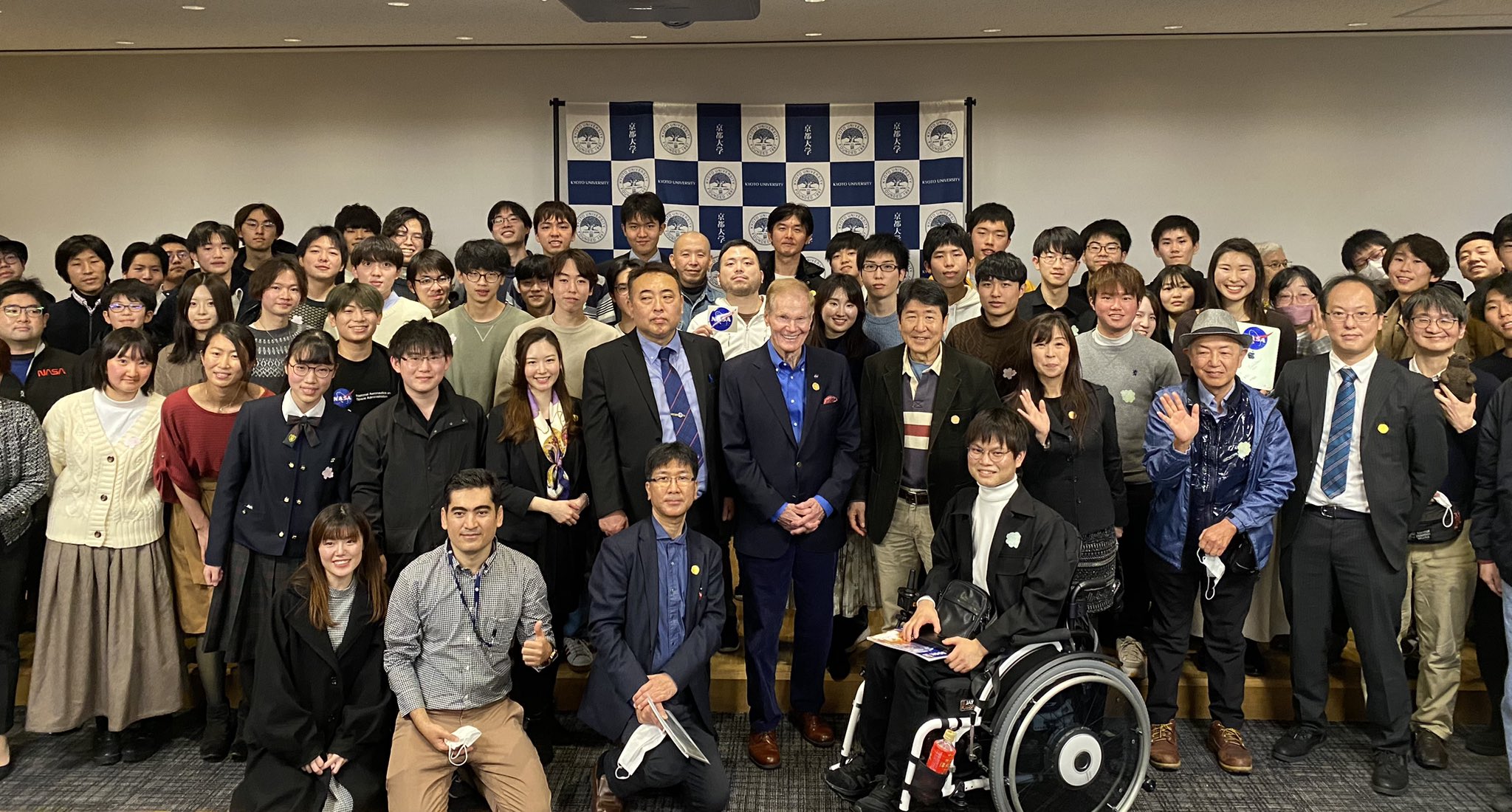
<紹介>
土井隆雄 京都大学大学院総合生存学館 特定教授
(以下土井)
みなさん、おはようございます。京都大学総合生存学館の土井隆雄です。今日は特別なゲストをお迎えしています。NASA長官Bill Nelsonさんと、それからMrs. Nelsonさんです。Nelson長官は1986年にスペースシャトルコロンビア号で宇宙に投じています。今日はNelson長官が宇宙についてのいろいろな話やNASAの仮想について色々と解説していただけることになっています。どうぞよろしくお願いします。ネルソン長官の話の後で質問の時間を設けていますので皆さん色々な質問を考えていてください。
(English Translation) Good morning. My name is Takao Doi. We have a very special guest with us today, and I would like to extend a hearty welcome to NASA Administrator Bill Nelson and Mrs. Nelson. Thank you very much for coming to Kyoto University today, and I would like to thank Secretary Bill Nelson, who was thrown into space aboard the Space Shuttle Columbia in 1986, for giving us a talk on space and NASA’s activities. I would like to start with Garvey McIntosh, NASA Asia, who will talk about his boss, Administrator Bill Nelson, and thank you, Garvey.
(訳 白樫)
おはようございます。土井隆雄です。本日は特別なゲストをお招きしています。NASAのBill Nelson長官とNelson夫人を心より歓迎させていただきたいと思います。本日は京都大学にお越しいただきまして、本当にありがとうございます。Bill Nelson長官は1986年、スペースシャトルコロンビア号に搭乗され、宇宙に投じられました。Bill Nelson長官には宇宙やNASAの活動についてご講演していただきます。まず、 NASAアジア担当のGarvey McIntosh氏に、彼の上司であるBill Nelson長官についてお話ししていただきたく存じます。Garveyさん、よろしくお願いします。
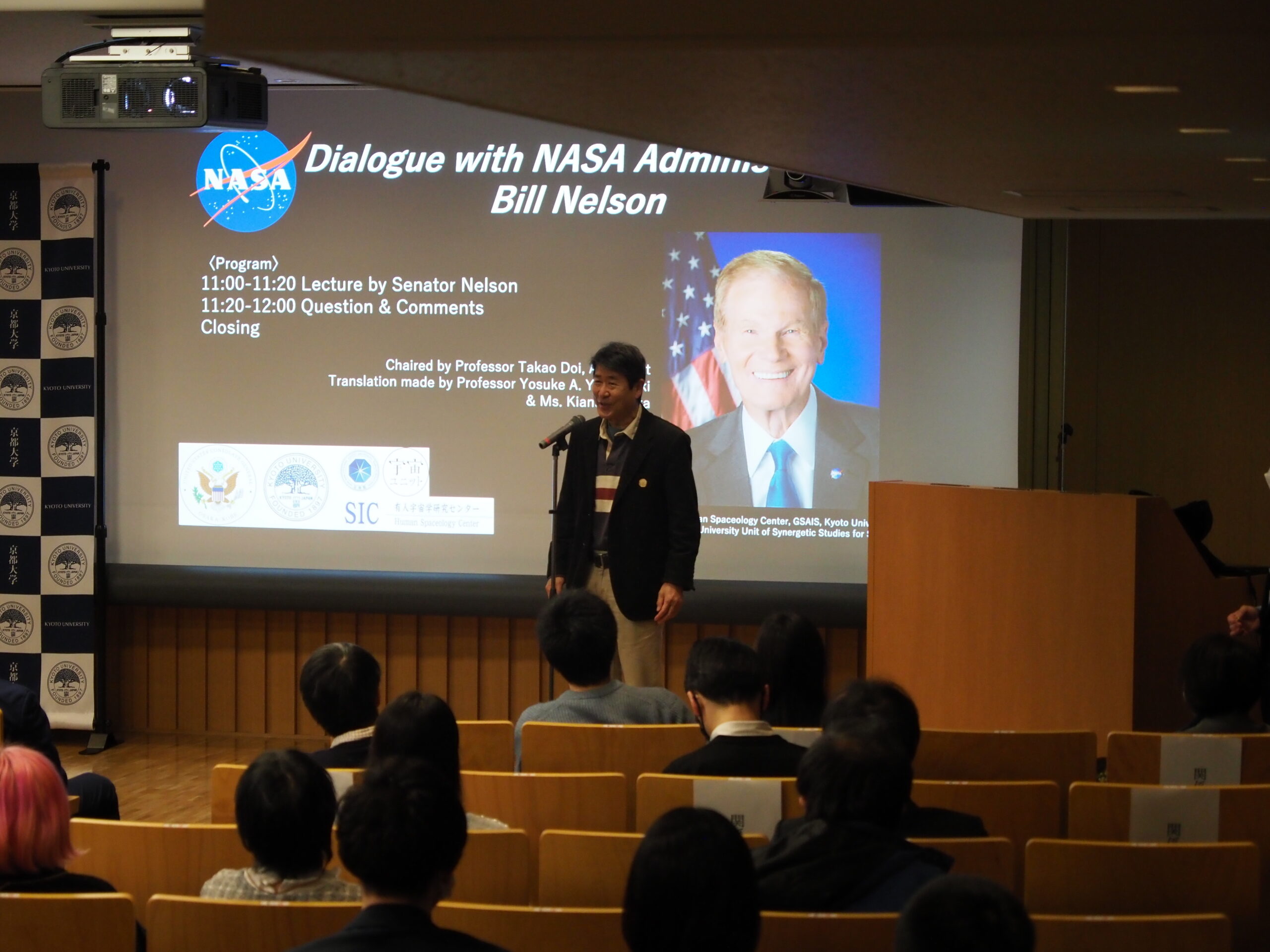
 Garvey McIntosh 在日アメリカ大使館NASA担当官
Garvey McIntosh 在日アメリカ大使館NASA担当官
NASA Asia Representative Garvey McIntosh
(以下Garvey)
Hello Everyone, and thank you Doi-san, Doi-san is really amazing, I have had a chance to know Doi-san since I have been here the past few years and he is really amazing, not only as an astronaut, but what he has done for Kyoto University. And as you can see with all of these students here, he is really good about keeping in touch with NASA and making sure that NASA and Japan as a whole, and NASA and Kyoto University have a very good relationship.
First I would like to, before I introduce my boss, I would like to introduce the NASA delegations that are here, and I would ask the NASA delegation to stand up so can know who they are. In addition to Senator Nelson here, we have the head of international relations, Karen Feldstein, the NASA chief of staff, Suzie Quinn, NASA speech writer Patrick Kelly, and NASA Senior International Program specialist Justin Tillman. And the person that keeps us all together, Grace Nelson. Also, when we come to events like this, we don’t do this by ourselves, and I’d like to say thank you to the, to the US Consulate here in Kansai and say, uh, introduce, uh, Neil Morena and Yuichi Sakata.
My boss, Senator Nelson, has been a lifetime public servant. He has served, the United States well in both the House of Representatives and the US Senate. As Doi-san mentioned, he flew on the space shuttle in 1986 and was appointed as appointed by President Biden almost two years ago to be the 14th confirmed NASA administrator. I’ve had a chance to, really get to know, Senator Nelson over the past few days in our travels to Tokyo, Nagoya, and Kyoto. And he is just an amazing person. And, just a great representation of the United States. I’d like to ask, um, Senator Nelson to come up and give us a presentation, Senator Nelson.
(訳 白樫)
みなさん、こんにちは。土井さん、ありがとうございます。土井さんは本当に素晴らしいお方です。私が日本に来てからここ2, 3年間、土井さんのことをずっとお聞きしておりました。土井さんは宇宙飛行士としてだけでなく、京都大学での活動も本当に素晴らしいお方です。学生の皆さまを見てもお分かりいただけますように、土井先生にはNASAと上手いこと連絡を取っていただき、NASAと日本が、NASAと京都大学が一体となって、アメリカ合衆国と日本が良い関係性を築けていると確信しております。本当にありがとうございます。まず、私の上司をご紹介する前に、NASAの代表団をご紹介させていただきます。代表団の皆様は立ち上がらなくても構いませんので、挙手していただけると幸いです。Nelson上院議員に加え、国際関係及び機関間関係を担当しておられます、Karen Feldstein氏、首席補佐官のSusie Quinn氏、スピーチライターのPatrick Kelly氏、NASA国際プログラムのスペシャリストJustin Tilman氏、そしてGrace Nelson氏です。また、このような講演は、わたしたちだけで成り立つものではありません。在日アメリカ領事館の村田氏と坂井氏にも深く御礼申し上げます。私の上司のNelson上院議員は生涯公務員で、下院と米国上院の両方で勤められました。土井さんがおっしゃったように、彼は1986年にスペースシャトルに搭乗され、およそ2年前にバイデン大統領から14番目のNASA長官に任命されました。私はここ数日、東京、名古屋、京都と旅行し、ネルソン上院議員と本当に知り合う機会を得ましたが、彼は素晴らしい人で、米国の素晴らしい代表者であります。
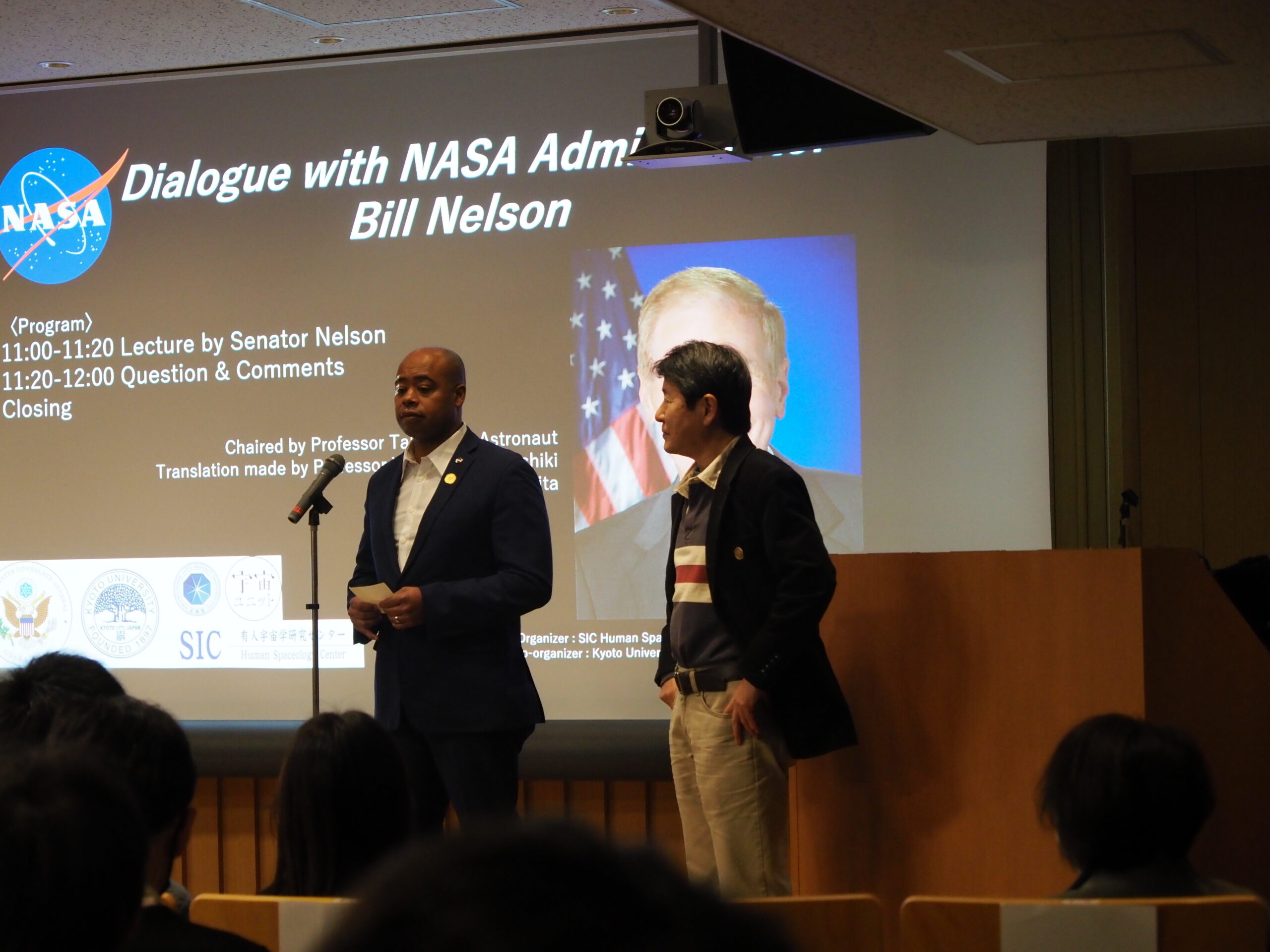
(土井)
Professor Doi
Garveyさん、ありがとうございます。
So, before starting, Senator Nelson’s presentation, we’d like to show our happiness to have you here at Kyoto University. So we’d like to present, a bouquet, some flowers to you. So to present, I would like to introduce Sekiyama, she is the boss of our department, to present the bouquet to Senator Nelson.
Nelson上院議員による講演を始める前に、Nelson長官に本日ここでご講演していただくことへの感謝の意を表明して、花束を贈呈させていただきたいと思います。積山先生、彼女は私が所属する部署の上司なのですが、積山先生にNelson上院議員へ花束を贈呈して頂きます。
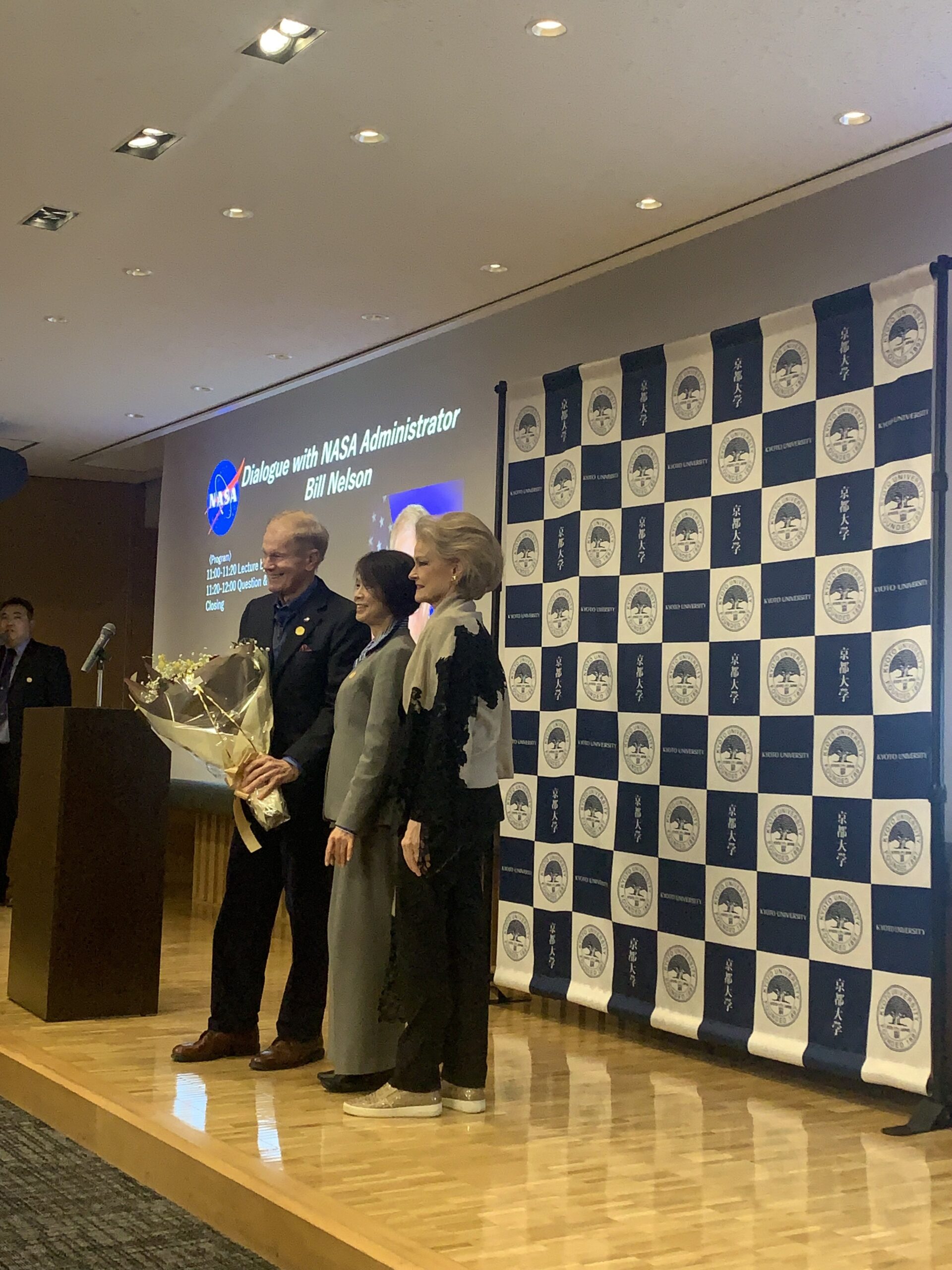
写真 ネルソン夫妻と積山薫大学院総合生存学館長
Photo: Mr. and Mrs. Nelson with Kaoru Sekiyama, Director of the Graduate School of Advanced Integrated Studies in Human Survivability
ではNelson上院議員、講演の準備の方は大丈夫でしょうか。よろしくお願いします。
Bill Nelson NASA 長官
(以下Senator Nelson)
I’m going to stop for interpretation then.
Thank you very much for your hospitality and your invitation to come and speak to you today.
通訳 山敷庸亮 京都大学大学院総合生存学館 教授*
(以下 山敷)
本日は手厚いおもてなしと、講演のご招待をしていただき、誠にありがとうございます。この中で英語を話す人はどれくらいいらっしゃいますか。この中で英語を話さない人はどれくらいいらっしゃいますか。(何人か英語を話さない方の手が上がったのをみて)では、通訳のために会話を止めながらお話しさせて頂きます。
(以下Senator Nelson)
We are in a golden age of space exploration. You’ve seen the pictures from the James Webb Space Telescope. It is positioned a million miles from Earth and it looks out into the dark of space. It has five space blankets the size of a tennis court that shielded from the light and the heat of the sun.
Okay, if, if you can hold the video, let me make a few comments.
What it has brought to us are pictures that are just hard to believe. We have captured the life, of the light of the formation of the first galaxy. Think of this, light that has traveled at the speed of light, 186,000 miles per second. And that light has traveled for 13 and a half billion years. That’s a long distance. The universe is very large. And that’s light only 300 million years after the very beginning, the very beginning being 13.8 billion years ago, determined by a NASA scientist that got the Nobel Prize for his discovery. So we are in a very large universe, and that universe is even expanding. And who knows, there may be a parallel universe. So the question is, is there other life out in the universe? What do you think?
(通訳 山敷)
我々は宇宙開発の黄金期を迎えています。James Webb宇宙望遠鏡からの画像をご覧になられましたか?James Webb望遠鏡は地球から約150万キロ彼方にあり、深宇宙の観測を行なっています。James Webb望遠鏡にはテニスコートに匹敵するほどの大きさの5枚のスペースブランケットが取り付けられていて、太陽の光や熱から望遠鏡を守っています(注* James Webbは近赤外線と中間赤外線分光観測のため、望遠鏡受講部を50K以下という超低温に保つ必要があるから)。ビデオを少し止めていただいて、James Webbのビデオを再生される前にまず一言申し上げてもよろしいでしょうか。
James Webb宇宙望遠鏡が送信してくる数々の画像は、本当に信じ難いものでした。我々は、宇宙で一番初めに誕生した銀河が形成するときに発生した光を捉えました。光が秒速18万6000マイル(約30万キロ)で宇宙空間を進むことを考えてみてください。観測された光は135億年かけて地球にやってきたのです(注*宇宙膨張による赤方偏移で波長が赤外線領域に伸びており、故にJames Webbで観測された)。とても長い距離ですね。宇宙は非常に広大です。また、その観測された光は宇宙誕生からたったの3億年しか経過していないときに発されたものです。138億年前、宇宙が誕生して間もない時です。 NASAの科学者によって同定され、彼はその発見の功績によりノーベル賞を受賞しました。私たちは非常に広大な宇宙に存在しており、宇宙はさらに拡大し続けています。 ひょっとしたらパラレル宇宙があるかもしれません。大きな疑問は、果たしてこの宇宙に、ほかの生命がいるか、ということです。みなさまはどう思われますか?
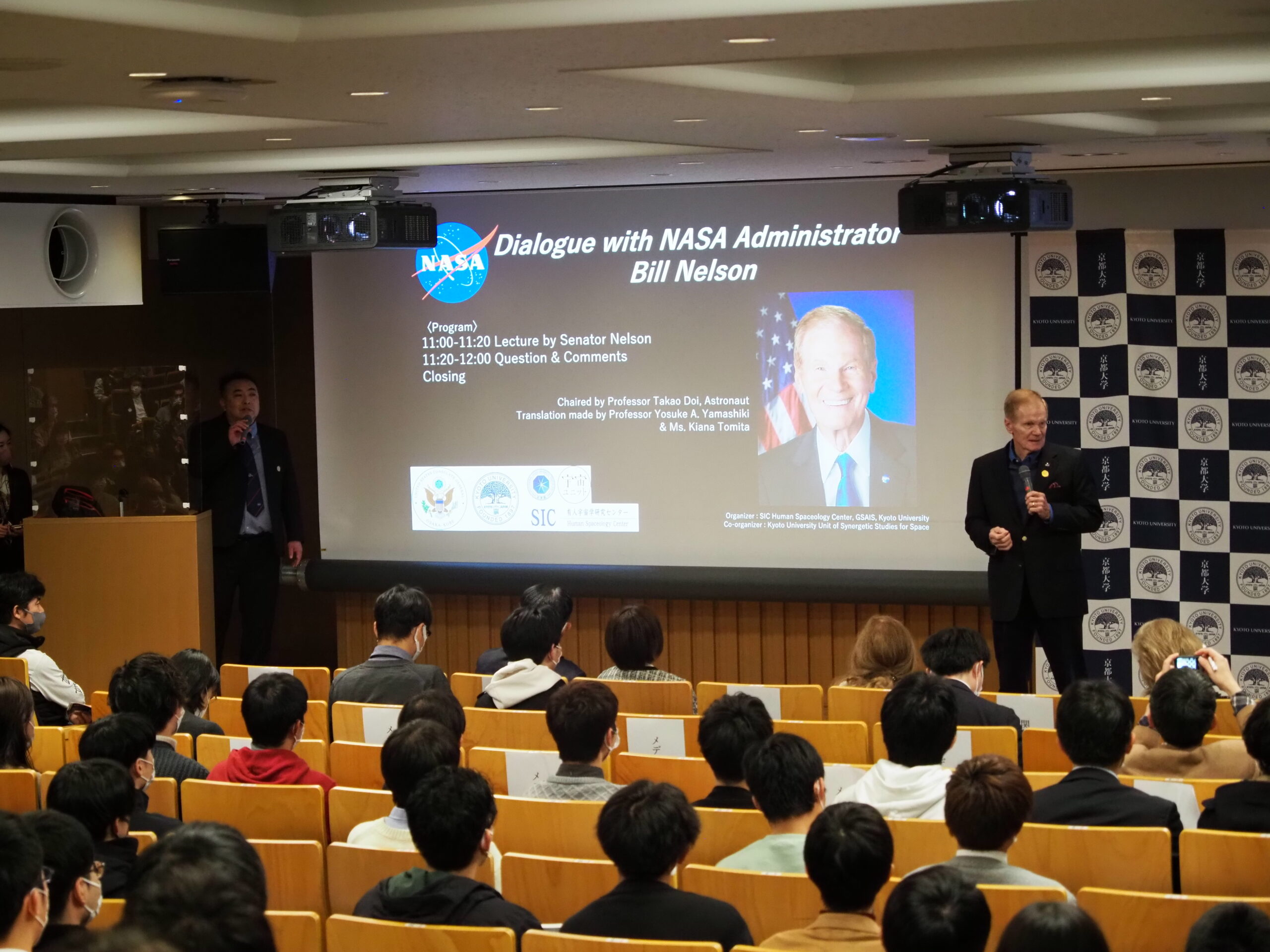
(Senator Nelson)
NASA is searching for life. So we are digging on the surface of March right now. We are drilling down and filling titanium tubes that large, and we will have them return to earth in 2031. The rover is on a dry lake bed where a river flowed into the lake.
So, millions and millions of years ago, we are going to see if there was evidence that there was life there then, but that’s just in our own solar system. If there was life there, was it developed? And if it was developed, was it civilized?
(通訳 山敷)
NASAは地球外生命体を探しています。今、NASAの火星探査機Perseveranceが火星の表面を掘っているところです。これくらいの大きさのチタンのチューブを用いて火星表面を削り、チューブに試料を詰めているところで、2031年にそのサンプルを地球に持ち帰る予定です。 Perseverance は今、太古の火星表面に川が流れ込んでいた、乾燥した湖床にいます。
我々は何十億年も昔の生命の痕跡があるのか、調べようとしているところです。しかし、これは太陽系内だけの話です。太陽系外に生命が存在するとしたら、生命は発達しているでしょうか?発達しているなら、果たして文明が構築されているのでしょうか?
What is the mathematical probability that there is life out in the universe? And so I ask our scientists that question to give me an answer.
Here’s what they said. Since our galaxy, the Milky Way galaxy has billions of stars or suns, and there are billions of galaxies with billions of suns. So, what is the mathematical probability that there is another earth-like planet revolving around a sun? The answer was at least 1 trillion stony mid-size planets revolving about a mid-sized sun. 1 trillion, at least 1 trillion. It may be 2 trillion, 3 trillion. But if there is another planet, and we are identifying these planets now with the James Webb Space telescope, and we can see the chemical content when it passes in front of the star, we can determine the chemical content when it passes in front of the star. We can determine the chemical content to see if it could support life.
That’ll be pretty interesting when we find out. But the distances are so far that it will be a long time before we can travel there.
宇宙に生命体が存在する数学的な確率はどれくらいでしょうか?NASAの科学者にこの質問を聞いてみたところ、このように答えが出ました。
我々のいる天の川銀河には何十億(*約2000億)個もの恒星があり、そしてこの宇宙にはその何十億もの恒星からなる銀河が何十億(*2000億-2兆)も存在します。では、恒星の周りを公転している地球に似た惑星が存在する数学的な確率はいくらでしょうか。答えは、「中型の星(*太陽型星)の周りを公転する中型(*地球サイズ)の岩石惑星は最低でも1兆個」でした。最低でも、1兆個、です。2, 3兆個ある可能性もあります。地球に似た惑星があった場合、ジェームズウェッブ宇宙望遠鏡でその惑星を確認し、その惑星が主星の前を通過するときに(*トランジット分光により)大気の化学物質組成を確認できる場合、その組成を同定し、本当にその惑星(の大気)が生命を支えることができるかどうかを調べます。
生命が存在しうる惑星を見つける瞬間は、とても面白いものでしょう。しかし、惑星との距離がありすぎて、我々がその惑星を訪問するには膨大な時間がかかってしまうかもしれません。
Right now with chemical propulsion, it’ll take us six to eight months to get to Mars. And once we get there, uh, we’ll have to stay on the surface for a year or two until the planet’s realigned so that we can get back in six or eight months. That’s why we have to develop new propulsion to get us, they’re faster. So this is what you are going to be able to do in your lifetimes. You may get evidence of additional life in the universe and in your lifetimes. You will also see humans go from earth to Mars and return safely.
You know, all of this is being made possible by people like you, along with people all over the earth in an international effort to explore space. Folks like Takao (Mr. Doi), he has blazed a trail for many others. And you go back to the beginning, in the early days when we put up John Glenn in orbit, we didn’t know how it was going to affect the human body.
Now, because of astronauts like Takao, we have a lot of data as to how we can keep humans alive in those conditions and bring them back safely. So this is a golden age of space exploration, but we are just beginning, the new beginning. And so, the James Webspace telescope has given us a new insight into that cosmos out there that we want to explore. It will help inform us better who we are, where we are, what we are, and where we are going.
現在、化学推進ロケットで火星まで6〜8ヶ月かかります。一度到着してしまうと、惑星が再び適当な位置に来て、6〜8か月で地球に戻れるようになるまで、1〜2年火星に滞在しなければなりません。だからこそ、我々はもっと速く進むような新しい形のロケット推進エンジンを開発しなければならないのです。
これはあなたたち(*この会場に集まられた学生の皆さん)が存命の間に取り組むことのできる課題です。あなたたちが存命の間に、宇宙で生命体の痕跡が見つかるかもしれません。また、あなたたちが存命の間に、人が地球から火星に旅立ち、地球に安全に帰還するのを目の当たりにするかもしれません。これらはすべて、宇宙を探索する国際的な活動を経て、世界中の人々とともにあなたたちのような人々によって実現することができます。たとえばここにいらっしゃる土井隆雄宇宙飛行士のように、先人たちは他の多くの人々のために道を切り開いてきました。昔、宇宙活動が始まったばかりの頃、John Glenn氏を周回軌道に送りましたが、それが人体にどのように影響するか分かっていませんでした。
土井隆雄氏のような宇宙飛行士のおかげで、現在、宇宙でどのように人の生命を維持し、無事に帰還させるかについて、たくさんのデータが蓄積しています。我々は宇宙開発の黄金期を迎えていますが、黄金期はまだ始まったばかりです。James Webb宇宙望遠鏡によって、我々が将来進出しようとしている宇宙について、新しい知見を得ているところです。
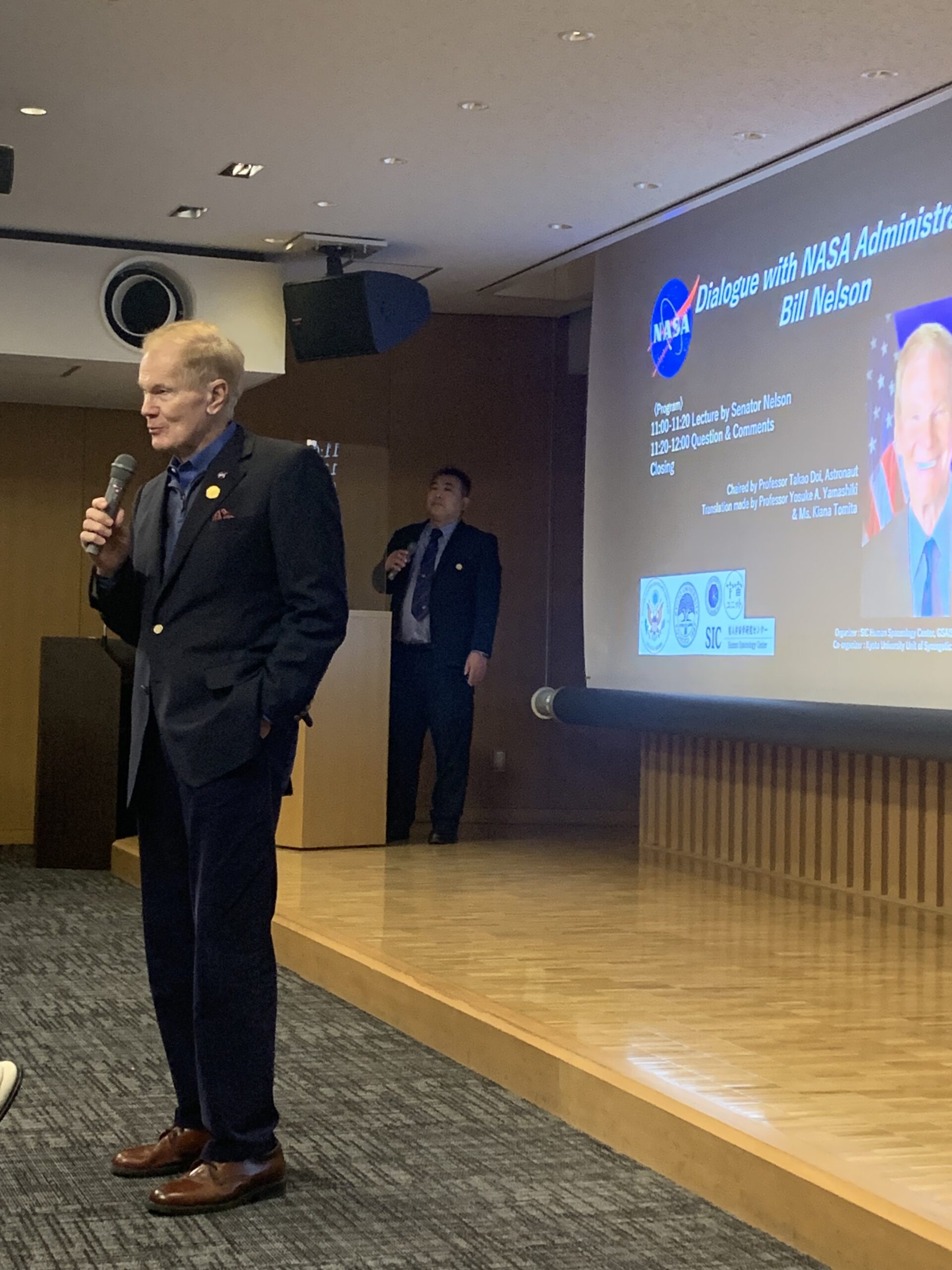
(Senator Nelson)
Now we prepare and are still preparing as we have for over 60 years to venture out into space.
The first, uh, human to go into space was a Soviet citizen named Yuri Gagarin. It was the great space race between the Soviet Union and the United States. And the Soviet Union, won the space race to go into orbit. We, the US were just getting ready to, launch into sub-orbit. And because it was a space race, most people don’t realize that the Soviet Union did not have the capability of landing the spacecraft. Soviets didn’t understand. So, they had astronaut cosmonaut, Yuri Gagarin bail out in a parachute to land safely. It was a space race that started because of politics and national rivalries. And then the US president, president John F. Kennedy, made a bold declaration. He said, we will go to the moon and return safely before the end of the decade. That was within nine years. But then he said something else very interesting. He said, ”we go to the moon, not because it’s easy, but because it’s hard.”
(通訳 山敷)
我々は、宇宙へ冒険するための準備を60年間以上続けており、いまだ完了していません。
人類で初めて宇宙へ行ったのは、ソビエト連邦のユーリイ・ガガーリンでした。ソビエトと米国の間で壮絶な宇宙開発競争が繰り広げられ、ソビエトが宇宙開発競争に勝ち、人類を初めて周回軌道に乗せましたが、その頃、米国ではサブオービットに向けて打ち上げる準備をしていたところでした。競争性が全面に出ていたため、ソビエトには宇宙船を着陸させる技術がないという点に気づく人はほとんどいませんでした。ソビエトは宇宙飛行士ユーリイ・ガガーリンをパラシュートで脱出させ、無事に帰還させました。政治的競争・国家同士の競争が原因で始まった宇宙開発競争でしたが、ソビエトの成果を受け、ジョンFケネディ大統領は大胆な宣言をしました。米国は月に人を送り、次の10年が終わるまでに、つまり9年以内に、無事に帰還させると宣言したのです。彼は他にも非常に面白いことを言いました。「私たちが月に行くのは、簡単だからではなく、困難だからだ」と。
Space is hard. And therefore we flew John Glenn and then the Mercury program, the Gemini program, and then the Apollo program.
But now we go back to the moon a different way. This is 50 years later after we were last on the moon, because this time we go with our international partners as well as our commercial partners. And we go to a different moon. Before we landed on the equator of the moon, where it is constantly in sunlight. Now we go to the very difficult part of the moon, the south pole of the moon, where there is only partial daylight and there are deep craters that are all completely shadowed. And so our landing has to be very precise.
That is now the Artemis program. And you are a part of the Artemis generation. It’s not the Apollo generation, it’s the new Artemis generation and it’s an international effort. So let’s roll the tape and let’s look at the Artemis program.
宇宙に行くのは非常に困難なことです。だからこそ、私たちはジョン・グレン宇宙飛行士を送り出し、マーキュリー計画、ジェミニ計画、そしてアポロ計画を実施しました。
しかし、我々は今もう一度別の方法で月に降り立とうとしています。最後に月に降り立ってから50年が経ちました。今回はさまざまな国の協力者だけでなく、民間会社の協力者も一緒に月に行きます。50年前とは違う月に行くのです。月の赤道部分は常に日光が当たるところですが、そこに到達する前に、赤道とは全く異なる場所、南極に行きます。月の南極には太陽光が一部にしか当たらず、完全に太陽光が当たらない深いクレーターもあります。したがって、私たちの着陸は非常に正確でなければなりません。
以上がアルテミス計画です。あなたたちはアルテミス世代の一員です。アポロ世代ではありません。新しいアルテミス世代であります。そして、アルテミス計画は国際的な取り組みによって成り立っています。それではビデオを見てみましょう。
(Senator Nelson)
And when we land the first astronauts in over a half-century on the moon, it will be the first woman on the moon and the next man. Did you notice in the video that the launch director was a woman? Did you, notice that our chief of staff is a woman and our deputy administrator that was on the video is a woman? So we go together and we go with an international crew.
In April, we will announce the first crew to go back to the moon. It will be an international crew. They will not land. They will circle the moon and return for the next flight to be the landing on the moon.
So we are in a new era of exploration, and you are going to be a part of it, Japan is a rock-solid partner of the United States.
Eventually, a Japanese astronaut will go and we’ve already announced, but not the person, to the mini space station. That will be in lunar orbit called Gateway. And we are talking with JAXA about, JAXA providing a pressurized rover for the surface of the moon, and further talks eventually about a Japanese astronaut as other international astronauts to participate in the activities on the surface of the moon.
Okay. Uh, why don’t we take some questions?
(通訳 山敷)
半世紀以上ぶりに月に着陸する宇宙飛行士は、月面に着陸する初の女性宇宙飛行士と、それに続く男性になるでしょう。ビデオに出演していたディレクターが女性であることに気づきましたか? 私たちのチーフスタッフが女性であることに気づきましたか?ビデオに出演していた副管理者が女性であることに気づきましたか? 我々は、性別・出身国関係なく、共に月を目指すのです。
4月には、月に戻るミッションの最初のクルーを発表します。国際的なクルーチームが結成される予定です。彼らは月面には着陸しません。月を周回し、次のフライトで月面に着陸する予定です。
我々は宇宙開発の新時代に生きており、あなた方はその一員です。日本は米国の固く強いパートナーです。
やがて日本人の宇宙飛行士もアルテミス計画で月に行くことになるでしょう。月軌道を回る予定の小さい宇宙ステーション「Gateway」へ送る日本人宇宙飛行士をすでに発表しました。JAXAとは、JAXAから月面を走るローバーを提供していただけるということを話し合っており、最終的には国際宇宙飛行士として日本人宇宙飛行士が月面での活動に参加することについても話し合っています。
それでは、いくつか質問をお受けします。
(土井)
Yes. Thank you very much for your presentation. Now we’ll move to the question and answer session, and if you have a question, please raise your hand also. And then, once you start, first, please say your name, your university and what you are doing or your department.
So please raise your hand.
Nelson長官、講演の方、ありがとうございました。それでは、Q&Aの時間に移りたいと思います。質問がございましたら、挙手してください。発言の際には、まず氏名、それから大学名、所属学科で何を研究しているか、から始めてください。
それでは挙手してください。
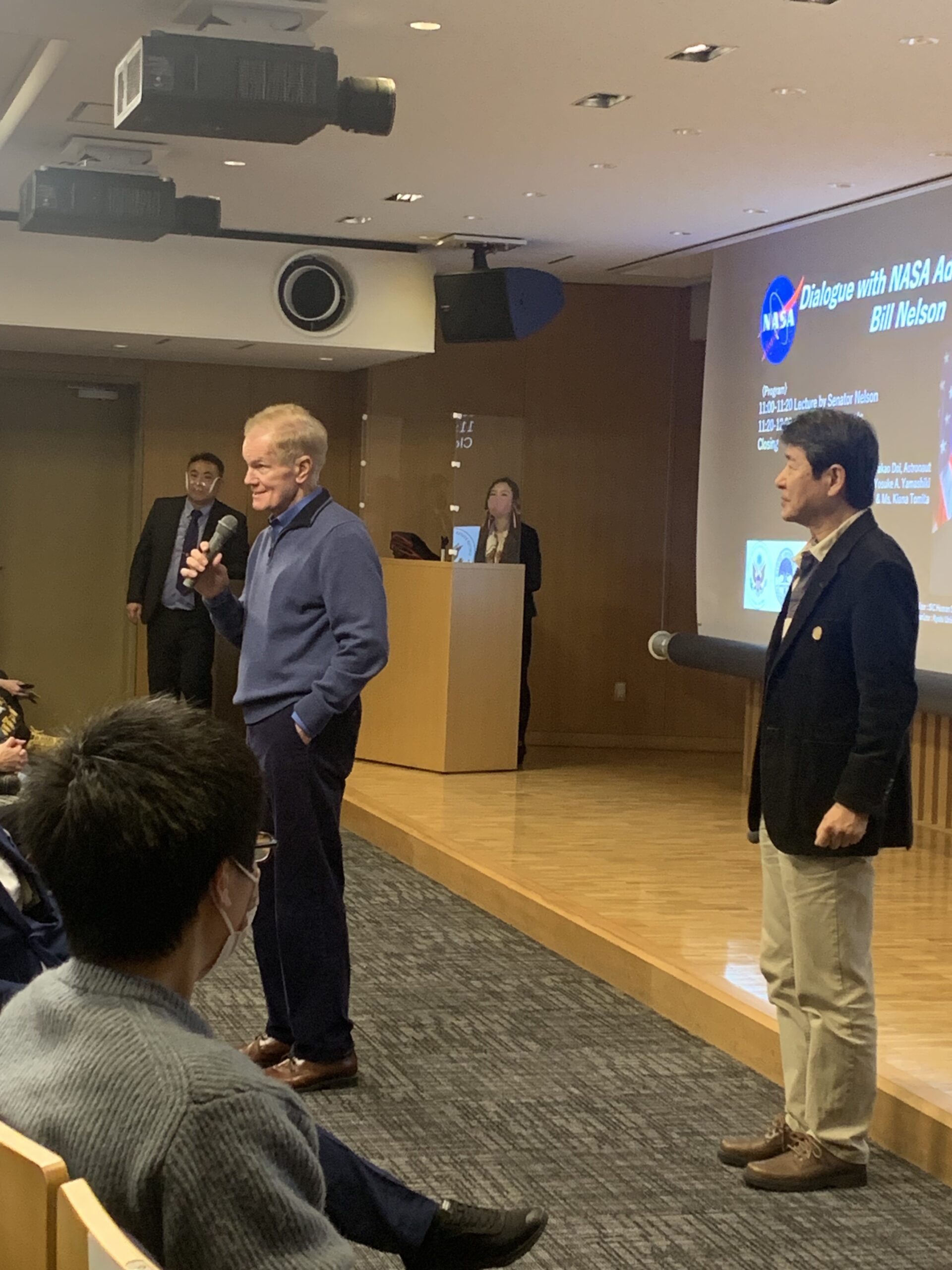
Q:
Thank you very much for your speech. My name is Toma Yamabuchi and I’m from the Department of Economics in Kyoto University. And I’m especially studying, poverty and statistics in my department. But, of course, I’m interested in the universe. Just out of curiosity, what is in your life, in your life so far, the most impressive experience, about the universe?
講演の方ありがとうございました。私の名前は山口で、所属は京都大学経済学部です。特に貧困や統計について勉強していますが、もちろん宇宙についても興味があります。単純に気になったのですが、長官にとってこれまでの人生で最も印象的な宇宙についての出来事は何ですか?
(Nelson長官)
When I looked out the window of the spacecraft orbiting the earth, every 90 minutes I was struck how beautiful the earth is, and yet how fragile it looks. I became more of an environmentalist by virtue of what I saw out the window of the spacecraft. The earth is so beautiful and yet you look at the rim of the earth and you could see a thin film. And that’s our atmosphere and that sustains all of our life. And I could see how, and this is a long time ago, I flew 37 years ago. I could see how we are messing it up.
I could see for example, by color contrast, how in the upper Amazon region, that’s where they were destroying the trees. And then I could look to the mouth of the Amazon River and I could see the silt for hundreds of miles out into the Atlantic, extra silt because they were destroying the trees upriver.
But I looked with additional eyes as I looked out the window, I looked with the eyes of a politician because I flew as a member of Congress. So when I looked at the earth, I did not see political divisions. I did not see racial divisions, and I did not see religious divisions. I saw that we were all in this together as citizens of planet Earth.
(通訳 冨田・山敷)
地球を90分で周回する宇宙ステーションの窓から外を見た時、私は地球がどれほど美しいのか、それでいてどれほど儚げなのか、とても感銘を受けました。宇宙ステーションの窓から地球を見て、それまで以上に環境保護主義者になりました。地球はとても美しく、薄い膜のようなもので縁取られていますが、それが私たちの大気であり、生命のすべてを支えています。私が宇宙へ行ったのは37年前ですが、人類がどれほど地球環境を汚染しているのか痛感しました。
たとえば、色のコントラストから、アマゾン川上流域でどれほど森林破壊が起こっているのかが分かりました。そしてアマゾン川の河口を見ると、河口から大西洋へ何百マイルも先まで沈泥が広がっているのが見えました。これは、人類がアマゾン川上流の木々を伐採しているからです。
しかし、窓の外を見たとき、他の視点からも地球を見ました。私は国会議員として飛んだので、政治的な視点からも地球を見ました。地球を見たとき、政治的な分裂は見えませんでした。人種の分裂を見ませんでしたし、宗教の分裂も見えませんでした。私たちは皆、共に地球に生きており、地球の住人であることを痛感しました。
Q:
Thank you for your great presentation and it was so fantastic to see you. The art film and other planets. My name is Wakana Hiramine, from Tokyo University of Science. I study pharmacy and I research cells between gravity and radiation. So I have a question about what is the biggest problem to work on the moon or go to Mars?
I think space radiation is the biggest problem because of its effect on our bodies. So what do you think? What is the biggest problem?
素晴らしいプレゼンテーションをありがとうございました。私は東京理科大学の平嶺と申します。私は薬学を専攻しており、微小重力と放射線の影響を受ける細胞の研究を行なっています。月面で活動したり、火星に行ったりするときに生じる、最も大きな問題は何ですか?
私は宇宙放射線が最も大きな問題になると思います。私たちの体に非常に悪影響を及ぼすからです。長官はどうお考えでしょうか。最も大きな問題は何だと思われますか。
(Nelson長官)
Radiation is certainly one of the problems that we have to solve because if there’s a solar explosion, then we’re fried. So we have to prepare some kind of safety closet by which our astronauts could retreat in order so that the radiation does not hit them. But just the logistics of enough supplies and food to get all the way to Mars is also a huge challenge.
Did you see the movie The Martian with Matt Damon? Well, Matt Damon grew potatoes on the surface of Mars. I’m not sure we can do that. As I mentioned earlier we need faster propulsion to get there. So we don’t, for the first time that we go, that we don’t have to stay so long. Right now it would be very difficult for us to go all the way to Mars to land, to return, and still keep up a crew of astronauts alive.
So we have many things to invent. Many new technologies.
確かに、放射線は解決しなければならない問題の1つです。太陽で爆発現象が生じると私たちは「丸焦げ」になってしまうからです。放射線が宇宙飛行士に当たらないように、宇宙飛行士が避難できるような安全な空間を準備する必要があります。しかし、火星に到達するための十分な物資と食料のロジスティクスも大きな課題です。
(通訳 冨田)
Matt Demon氏主演のオデッセイという映画をご存知ですか? Matt Demon氏は火星でジャガイモを栽培していましたが、実際にそれができるのか、私には分かりません。そして先述の通り、それほど長く滞在する必要がないように、より速い推進エンジンが必要です。 今のところ、火星まで行き、着陸し、宇宙飛行士が生きたまま帰還することは非常に困難です。
ですから、我々には開発しなければならない技術が多くあります。
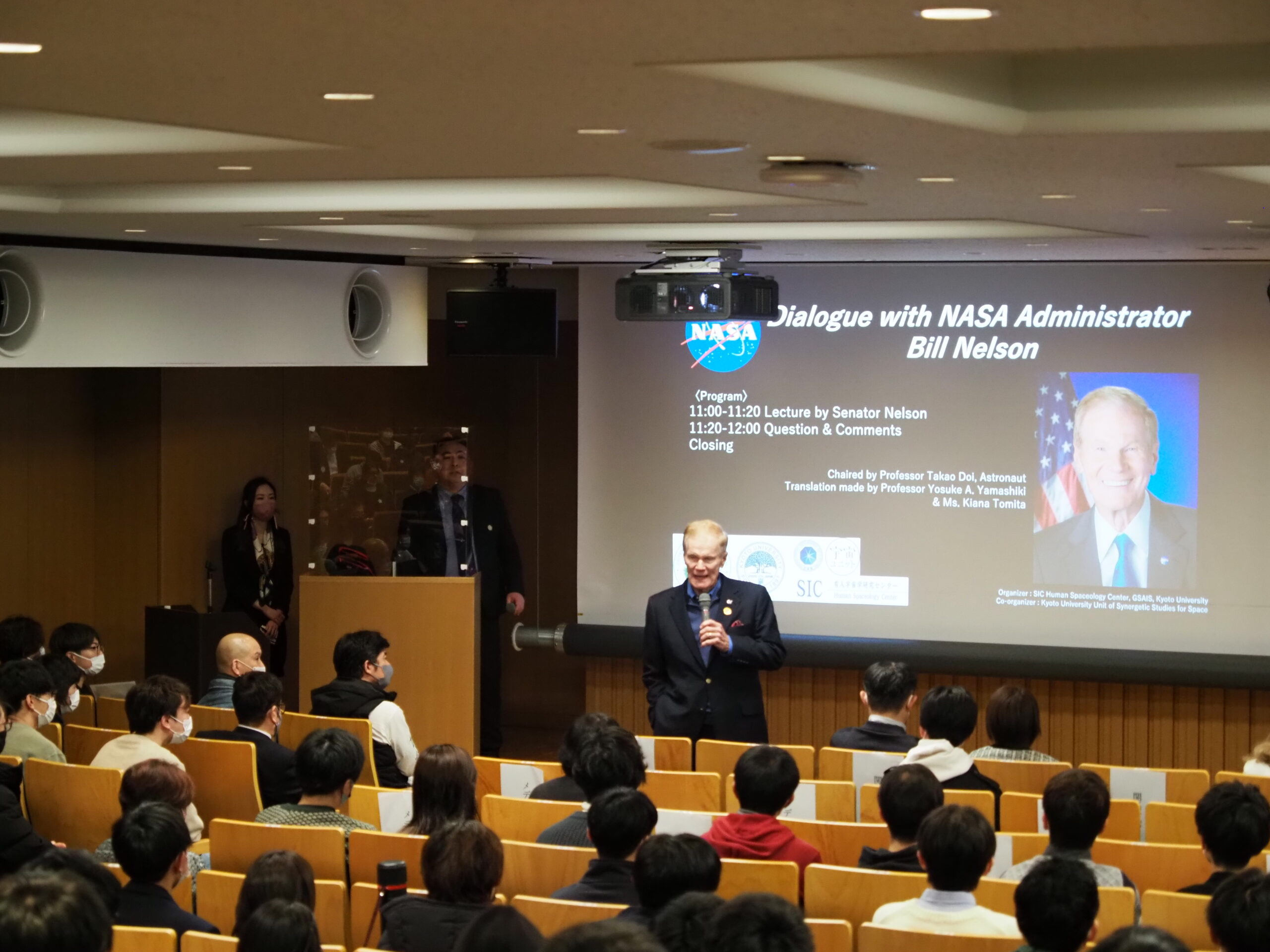
Q:
Thank you for an informative presentation. I’m Shinichi Deguchi from Tokyo, my major is actually in humanities, especially English literature, and culture at the university. But, I’m interested in space exploration and space policy, not only the US but also Japan.
So NASA has various experiences in the field of, space exploration in lower orbit. After 2030, after NASA stops operating the ISS, how will NASA take the initial leap of human exploration in lower orbit?
有益なプレゼンテーションをありがとうございました。私は東京から来ました出口です。人文科学を勉強しており、特に英文学と英語圏文化を専攻していますが、米国・日本双方の宇宙探査や宇宙政策にも興味があります。
NASAは低軌道飛行の分野でさまざまな経験を積まれていますが、2030年以降にISSの運用を停止した後、NASAはどのようにして低軌道での有人探査の主導権を握るのでしょうか。
(Nelson長官)
In 2031, we are going to deorbit the International Space Station. By then we will have commercial space stations so that we can utilize them and NASA can concentrate our efforts and our resources further out as we go to Mars and beyond.
(通訳 山敷)
2031年には、ISSを軌道から外す予定です。その頃までには、民間の宇宙ステーションを配置し、NASAが利用できるように、そして火星やその先に行くときにそちらにより注力できるようにします。
Q:
Thank you for the presentation. It was an honor for me. My name is (Name), I studied law university and I have two questions. One is, I know that in the Artemis program, the ultimate goal is reaching Mars. And so my question is, what is the goal for NASA after reaching Mars? And for the second question, I’d like to know, how I can be a part of this golden age. Like, how students not majoring in science can be part of this program.
講演、ありがとうございました。畏怖の念を感じずにはいられませんでした。私の名前は(お名前)で、法学を勉強しています。二つ質問があります。1つ目に、アルテミス計画の最終目標が火星であることはわかっているのですが、火星に到達した後のNASAの目標は何でしょうか? 2つ目に、どのようにしたら私もこの黄金時代の一員になれるのかを知りたいです。理系以外の学生もアルテミス計画に関わる事ができるのでしょうか?
(Nelson長官)
You are studying law.
I am a lawyer.
So, you don’t have to be a scientist to go to space. Now, I’m the only lawyer that’s gone to space and NASA did not publicize that fact, by the way. There is going to be so much requirements for all kinds of educated astronauts as we venture further out and eventually colonize worlds. So I encourage you to keep up your interest in space, work hard in your law studies become a good lawyer. And then, let’s see what happens.
Oh, and what do we do after Mars?
I don’t know, but we’re going to continue to venture out. What if, we find out by then that there is some intelligent civilization somewhere out there in the cosmos? We would certainly try to contact them. But if they are a hundred, light years away, it’s going to be a long time before we can travel that far.
あなたは法律を勉強していますね。私は弁護士です。
宇宙へ行くのに科学者である必要はありません。ちなみに、私は宇宙へ行った唯一の弁護士であり、NASAはこのことを公表していません。今後さらに宇宙へ飛び出し、最終的に月面や火星上にコロニーを形成するときには、教育を受けた宇宙飛行士になるためにはそれがどんな宇宙飛行士でも、非常に多くの要件が必要となってくるでしょう。ですから、宇宙へ関心を持ち続け、法律の勉強に一生懸命取り組み、優れた弁護士になって欲しいと思います。それからどうなるかですね。
あ、あと火星に到達した後何をするか、ですね。
分かりません。でも、それから後もさらに探求を進めていくつもりです。もし、そのころに宇宙のどこかに知的文明があることがわかったら?私は必ず彼らとコンタクトを取ろうとするでしょう。でも、もしその(宇宙の)文明が100光年彼方にあるとすれば、私たちがその距離を移動できるようになるには、まだまだ時間がかかりそうですね。
Q:
Thank you for your speech. I got very excited we get to see the Artemis program. I’m in Horikawa High School and my name is Shimohashi Saya and we research about acceleration risk. I have one question. Now, as far as I know, there is few rules about space. So what kind of rule do we need to go to space more?
ご講演、ありがとうございました。アルテミスのプログラムを見ることができ、とても興奮しています。私は堀川高校に通っていて、下橋沙耶と申します。私たちは加速度リスクについて研究しています。一つ質問があります。現在、私の知る限りでは、宇宙に関する規約はごくわずかしかありません。今後宇宙へ進出していくためには、どのようなルールが必要なのでしょうか?
(Nelson長官)
Okay, the question is what kind of laws or regulations do we need when we go to space?
Well, to protect planet Earth, we have some space treaties in place. Not all nations have signed them. We have space treaties not to blow up nuclear weapons in space. Those are still in place and have been observed. But there will need to be space laws passed on how you treat each other in space. And we have started one such set of regulations called the Artemis Accords. 22 nations have signed the Artemis Accords and it’s a set of rules that we expect everybody in space to agree to, such as, use of space for peaceful purposes, come to the assistance of another in an emergency, common sense things, such as that.
So that’s a good project for you to work on as a lawyer.
つまり質問は、宇宙へ行くためにはどのような法律や規制が必要なのか、ということですね?
地球を保護するために、いくつかの宇宙条約を締結しています。しかし、すべての国が批准しているわけではありません。核兵器を宇宙で爆発させないという宇宙条約があります。これは現在も施行されており、守られています。しかし、宇宙でどのように各人がふるまうべきなのかについては、さまざまな宇宙法を通すことが必要になるでしょう。我々はそのような規約の1つとして、「アルテミス協定」という規約を実行し始めました。22カ国が「アルテミス協定」に署名しており、この協定では、平和目的のために宇宙を利用すること、緊急時には他人を助けること、非常識な行いはしない、などといった事項に、宇宙で暮らすすべての人が合意することを求めます。
ですから、弁護士として宇宙法に取り組むのはおすすめです。
Q:
Thank you for your speech. I’m Aika Sano. I’m studying space engineering, especially physics. I have a question for you about space development, especially about human space development. Now the international project is directed by NASA, mainly. But what do you think the future projects will also be directed by NASA or other, for example, JAXA and other countries, partially countries, future… I mean that the project will be conducted by country and corporate will be consisted or also conducted under direction of NASA? What do you think?
ご講演ありがとうございました。京都大学工学部の佐野愛華です。私は宇宙工学、特に物理工学を勉強しています。宇宙開発、特に有人宇宙開発について質問させてください。現在、国際プロジェクトは主にNASAによって指揮されています。しかし、今後のプロジェクトは、NASAによって運営されるのでしょうか、それとも、例えばJAXAや他国の宇宙機関といったNASA以外の機関によって運営されるのでしょうか、どうお考えですか?つまり、今後のプロジェクトは他の国によって運営され協力が付随していくのか、それとも引き続きずっとNASAの指揮のもと行われてゆくのか、ということです。
(Nelson長官)
The question is, will this be an international effort or will it be directed by NASA?
It will be an international effort and it already is.
For example, we operate with 16 nations on the International Space Station, NASA cannot alone operate the Space station. We operated with the Russians, we built it with the Russians, no politics. Japan has a major module called KIBO on the International Space Station. The European Space Agency has another major module. One whole section of the International Space Station is the Russian section.
He’s the expert (smiled at Mr. Doi).
(Nelson長官)
つまり質問は、これからの宇宙開発は国際的な取り組みになっていくのか、それともNASAが指揮していくのか、ということですね。
国際的な取り組みになるでしょうし、すでにそうなっています。
例えば、国際宇宙ステーションは16カ国で運用していますが、NASAだけでは宇宙ステーションを運用することはできません。ロシアと一緒に運営し、ロシアと一緒に作ったのです。そこに政治はありません。日本は国際宇宙ステーションに「きぼう」という大きなモジュールを設置しています。ESAも大きなモジュールをもっています。また、国際宇宙ステーションの1つの区画全体がロシアの区画になっています。
(Takao Doi)
Well, yes, the Space Station is composed of 15 different countries and we started designing it in 1985, and it took us about 20 years for Japan to finally attach the Japanese module, KIBO station. And since then many astronauts more than, uh, almost 10 Japanese astronauts flew to the Space station. So the Space Station is a wonderful place for us, the international partners to work with. But, we are trying to go beyond the International Space Station to the moon and Mars and I’m sure many countries being good with Japan are going to work with NASA and the United States and exploring us together.
国際宇宙ステーションは15カ国で構成されていますが、1985年に設計を開始し、約20年かけてようやく日本が「きぼう」日本実験棟を搭載することができました。それ以来、10人ほどの日本人宇宙飛行士が国際宇宙ステーションに送られています。このように、国際宇宙ステーションでは国際的なパートナーとして共に連携を取り合っており、私たちにとって非常に素晴らしい場所なのです。しかし、今私たちは国際宇宙ステーションをさらに越えて、月や火星に向かおうとしており、その際は日本と良く連携しているさまざまな国々がNASAや米国と連携しあい、我々は共に進出していくだろうと私は確信しております。
Thank you very much. We are now closing the presentation by Senator Nelson. So please give him again the claps. Thank you very much, Bill.
Also, before closing, we would like to give you a souvenir from Kyoto University.
それでは、ネルソン議員による講演を終わりたいと思います。もう一度拍手の方、お願いします。本当にありがとうございました。
それから、京都大学からお土産をお渡ししたいと思います。
それでは、私たちの部署からもお土産を差し上げたいと思います。はい。
<このあと、山敷教授による、京都大学のシルクネクタイの贈呈>
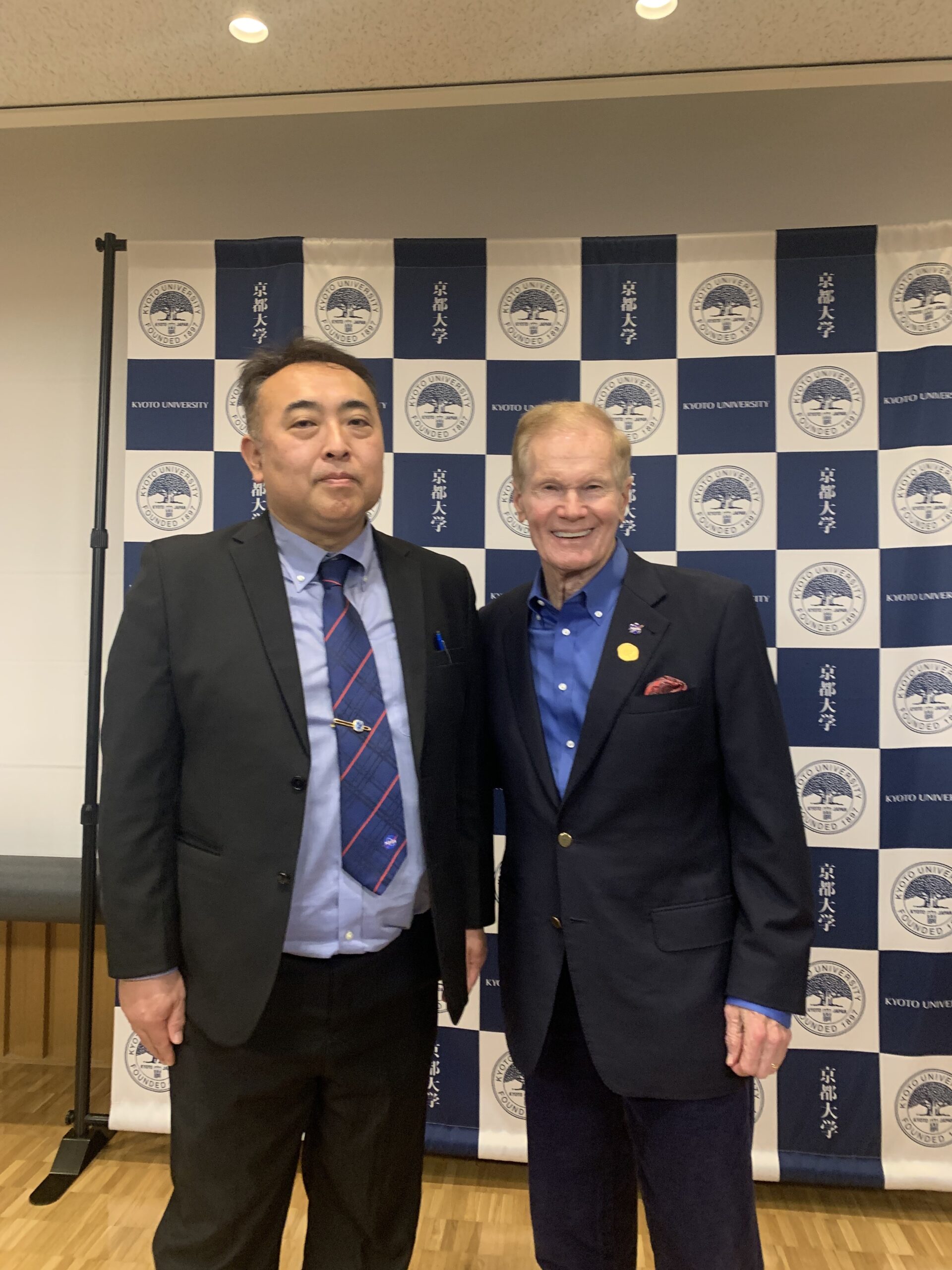
<つづいて、大学院生 新原有紗さんによる、京都大学のペンケースの贈呈>
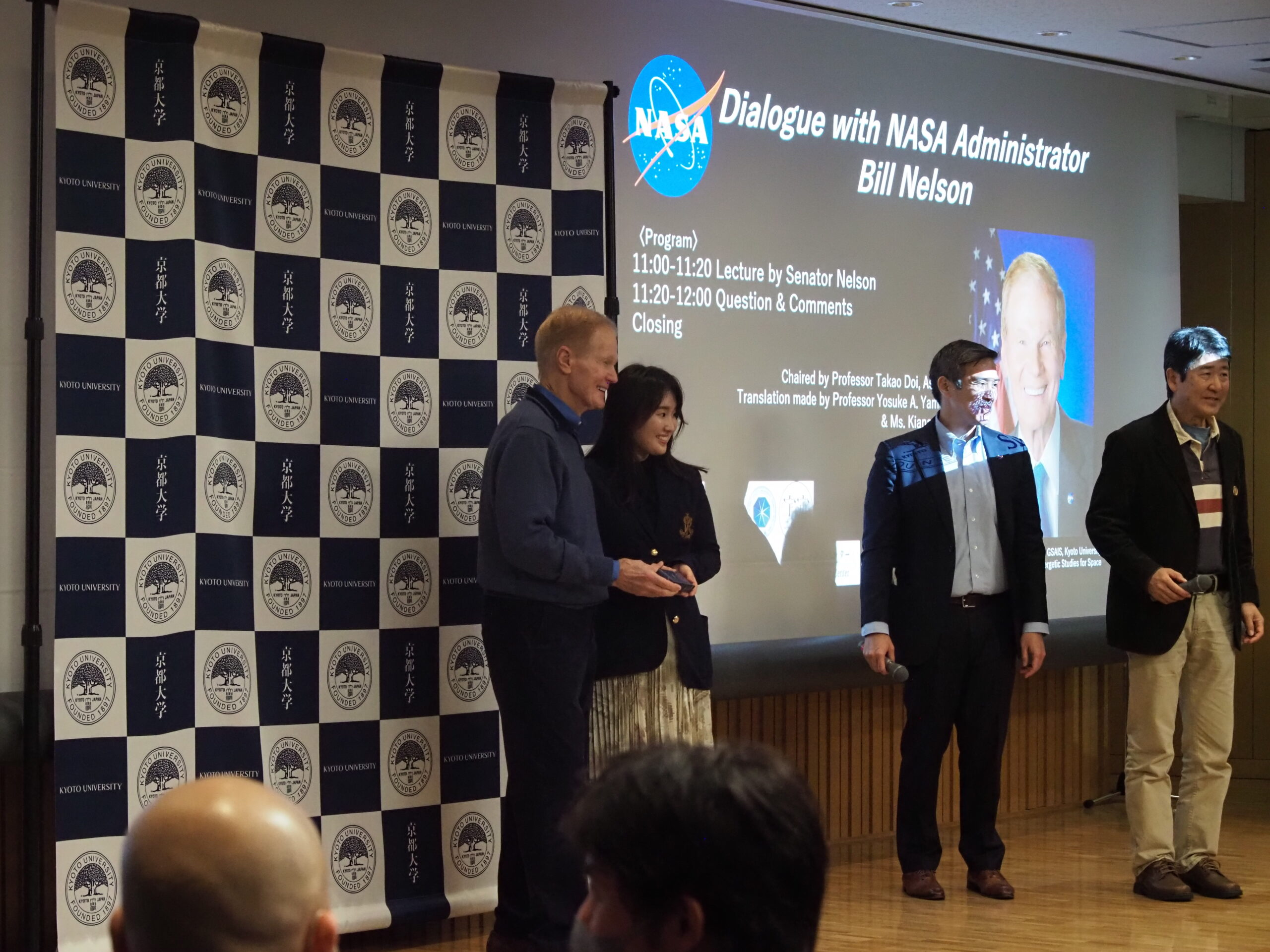
OLYMPUS DIGITAL CAMERA
<そして、土井隆雄宇宙飛行士による、プレゼントの贈呈と、長官からのお返し>
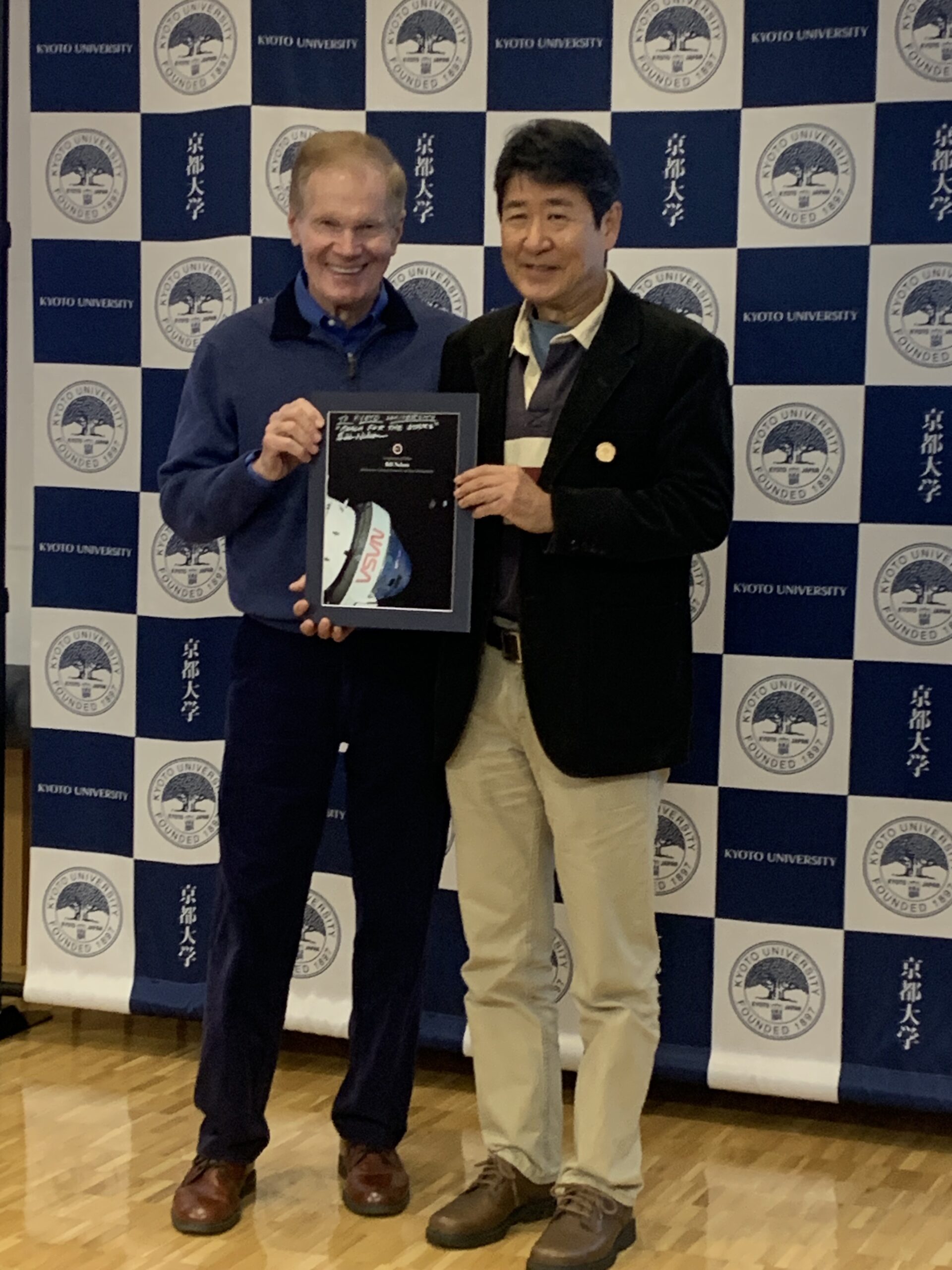
<通訳の冨田キアナさんと長官>
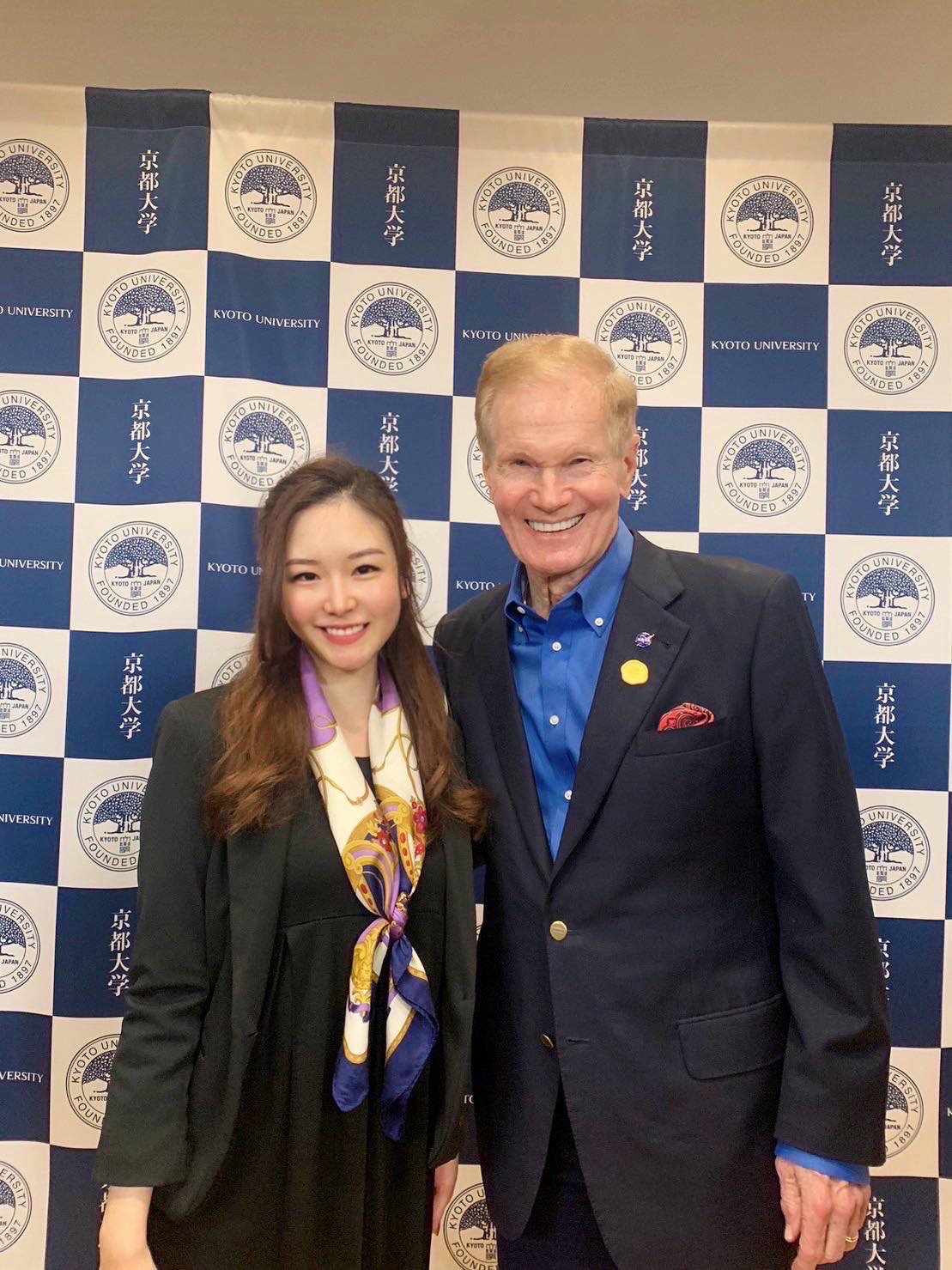
Okay thank you very much.
Thank you very much.
So that’s all that please have a seat.
Yes, please. So she’s going to present thanks to NASA.
Now, uh, we are going to close this presentation session and now after this, we are going to have the press interview so students can stay here.
それでは、ありがとうございました。
ありがとうございました。
では、これで終わりますので、お席にお座りください。
はい、どうぞ。それではNASAに感謝の意を表していただきます。
それでは、この発表会を終了します。この後、記者会見を行いますので、生徒の皆さんはここに残ってください。
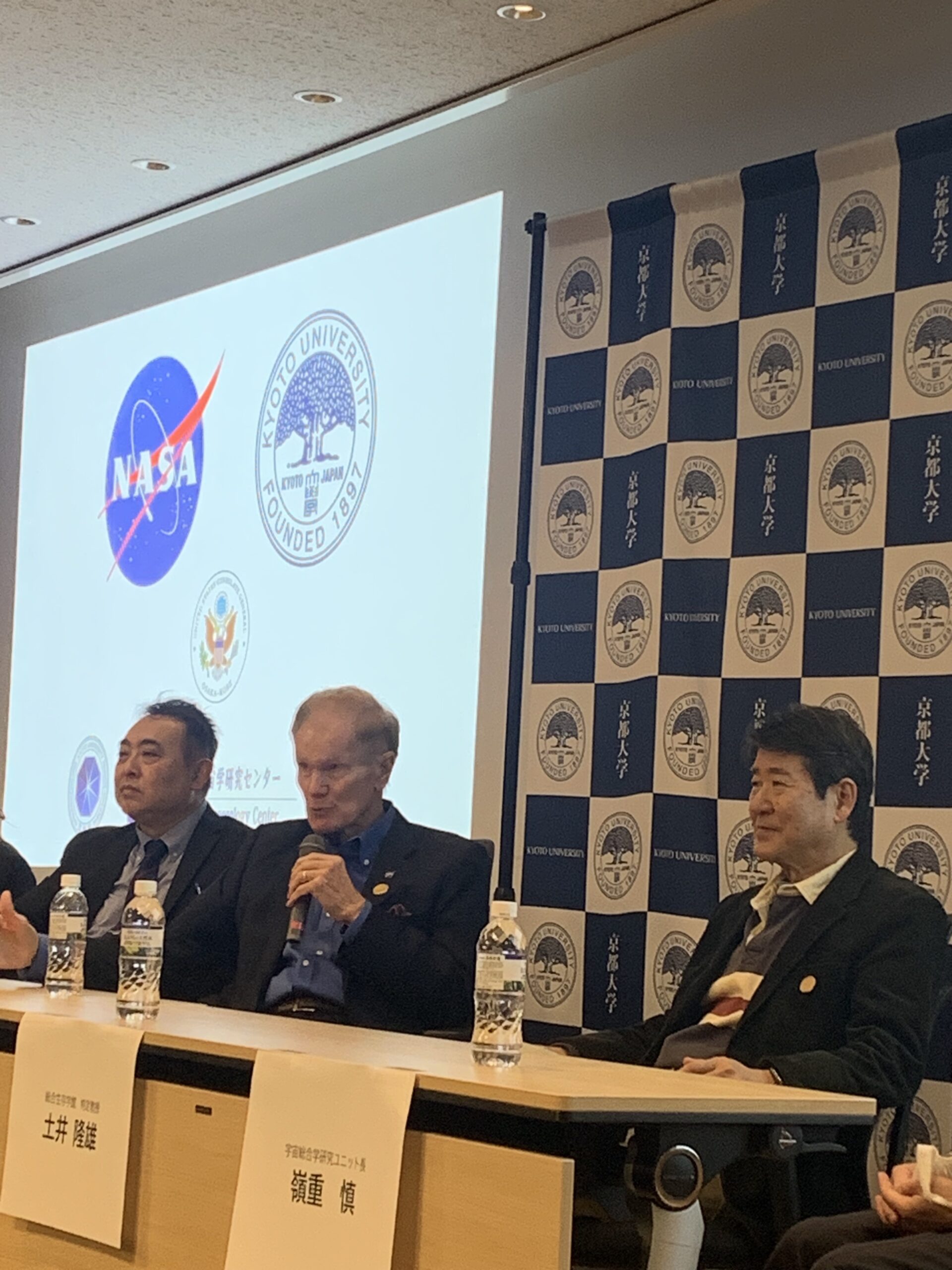
Q:
Thank you for your presentation. I’m Masuda from Yomiuri newspaper. What does expect NASA expect from Japan and Kyoto University?
ご講演ありがとうございました。私は読売新聞の増田というものです。NASAは日本、特に京都大学に何を期待しているのでしょうか?
(Nelson長官)
The question is, what does NASA expect from Japan in our overall space program?
And the second question is, what do we expect from Kyoto, the university? Well, first of all, understand that we partner with many universities all over the world. For example, we were talking about the James Webb, space telescope. One of the main instruments that is receiving the mid-level, light, that is in the infrared spectrum.
That instrument was made by the University of Edinburg in Scotland, and the principal investigator is there. And so too, this is the case with so many of our projects all over the world. We partner with companies and we partner with academic institutions, and universities.
With regard to your first question, what does NASA expect of Japan? We have a great relationship. It’s rock solid with the Japanese government overall on defense, on intelligence, on protection of the Pacific arena. And that agreement friendship extends to the civilian space program as well.
And I have described that in detail, in the remarks and the answers to the questions this morning.
Look how our two economies are tied together on things other than space. Our common interests in defense are tied together.
Look in space, how we are tied together. Mitsubishi is doing the pressurized rover for the moon. Out of the space program becomes, innumerable jobs that are produced, demands for higher education, the development of new technologies. All of this is happening because of a relationship between NASA and our partner countries.
質問ですが、NASAは宇宙開発全体において日本に何を期待しているのでしょうか?
そして、2つ目の質問は、京都大学に何を期待するかということです。まず、NASAは世界中の多くの大学と提携しております。例えば、先ほどジェームス・ウェッブ宇宙望遠鏡の話をしました。ジェームス・ウェッブ宇宙望遠鏡の主要な観測装置の1つは、近赤外線スペクトルの分光観測装置です。
この装置はスコットランドのエディンバーグ大学によって作られ、研究責任者がそこにいます。このように、私たちのプロジェクトは世界中にたくさんあります。私たちは企業とも提携していますし、学術機関や大学とも提携しています。
最初の質問ですが、NASAが日本に期待することは何でしょうか?私たちは素晴らしい関係を築いています。日本政府とは、防衛、情報、太平洋地域の保護など、全般的に強固な関係を築いています。そして、その友好関係は民間の宇宙開発にも及んでいます。
このことは、今朝の講演や質問への回答で詳しく説明しました。
私たちの2つの経済が、宇宙以外のことで、どのように結びついているかを見てください。防衛の分野でも、私たちの共通の関心事は結びついています。
宇宙では、私たちがどのように結びついているかを見てください。三菱は月探査の有人与圧ローバを開発しています。宇宙開発から生まれる無数の仕事、高等教育の需要、新しい技術の開発。これらはすべて、NASAとパートナー国の関係によってもたらされているのです。
Q:
My name is Atsuko from Kyoto Shinbun, the local newspaper. So could you tell us your impression to talk with young Japanese students?
京都新聞の敦子です。日本の若い学生たちと話をしてみての感想を聞かせてください。
(Senator Nelson)
The question is, what is my impression of you? You’re very bright and you’re very interested in space.
Who wants to fly in space?
Interestingly, I just talked to a high school up in Nagoya and I asked that question of a small group of students, and there was only one student that raised his hand.
But no wonder many of you want to fly in space because you’ve got a role model who flew in space.
(Nelson長官)
質問ですが、私のみなさんに対する印象でしょうか?皆さんはとても聡明で、宇宙にとても興味を持っています。
誰が宇宙で飛びたいと思うでしょうか?
という質問をしたところ、手を挙げたのはたった1人だけでした。
でも、京都大学では、(土井隆雄)宇宙飛行士というロールモデルがいるのですから、多くの人が宇宙飛行をしたいと思うのも不思議ではありません。
Q:
How does NASA cooperate with the Human Spaceology Center at Kyoto University?
NASAは、京都大学の有人宇宙センターとどのように協力しているのでしょうか?
(Nelson長官)
Well, we already are, I don’t know the individual, experiments, but I am sure that Kyoto has grants that works together. Here’s a good example right here. You’ve got a professor that not only is an expert in space, but can bring you personal experiences about space. So, your university is like so many other universities that we have a good a relationship with.
And yes, please, if you would.
京都大学には、NASAとの共同研究を行うための予算があります。ここに土井宇宙飛行士という非常に良い例があります。彼は宇宙の専門家であるだけでなく、宇宙ミッションに関する2度の宇宙滞在経験を持っている教授がいますよね。このように、京都大学は他の多くの協力関係にある大学と同じように、私たちNASAと良い関係を築いているのです。
Doi:
Okay, so let me just add a couple of things now. Kyoto University is developing a satellite, made of wood for the first time in the world. And this satellite will be launched to space from the International Space Station. And also this satellite will be launched to space by the United Nations company, I mean, the company of the United States of America. Also, we have been working with Biosphere 2 at Arizona university, also working with NASA.
So we, we have organized space camps for the last three years. So we have been working with NASA through many different fields. Thank you very much.
土井
では、今、いくつか補足させてください。京都大学は、世界で初めて木造の人工衛星を開発しています。この衛星は国際宇宙ステーションから宇宙に打ち上げられる予定です。また、この衛星は国際企業、つまりアメリカの会社によって宇宙に打ち上げられる予定です。また、私たちはアリゾナ大学のバイオスフィア2や、NASAとも協力しています。
この3年間は、このように宇宙キャンプを開催しています。このように、私たちはさまざまな分野を通じてNASAと協力しています。ありがとうございました。
山敷
NASAとの協力において、NASA/GSFCとの長期間の協力関係のもと、3月から、Vladimir Airapetian教授が1ヶ月京都大学に特別招聘教授として滞在します。
Q:
Can you give us a message for the young generation people who are willing to go to space?
これから宇宙へ行こうとしている若い世代の人たちにメッセージをお願いします。
(Nelson長官)
You are part of the Artemis generation, you are going to explore the cosmos. Study hard. Just think, what is going to come out of this Artemis generation? Look to history, what came out of the apollo generation? Mathematicians, scientists, technologists, engineers , lawyers. It’s a whole new exciting field as we venture out into the universe. And as we say with regard to the James Webb telescope; we will get answers to the questions that we don’t even know what the questions are, as we explore and learn, and learn, and explore and learn. So that is the excitement of the future, and that’s your generation.
皆さんはアルテミス世代の一員であり、宇宙を探検することになるのです。一生懸命勉強してください。このアルテミス世代から何が生まれるか、考えてみてください。アポロの世代から何が生まれたか、歴史を振り返ってみてください。数学者、科学者、技術者、エンジニア、弁護士….。みなさまがたが宇宙へ飛び出せば、それはまったく新しいエキサイティングな分野となるのです。そして、ジェームス・ウェッブ望遠鏡のように、私たちが探索し、学び、探索し、学ぶことで、私たちがまだ答えをしらない疑問への答えが見つかるでしょう。それが未来の興奮であり、あなた方の世代が享受するものなのです。
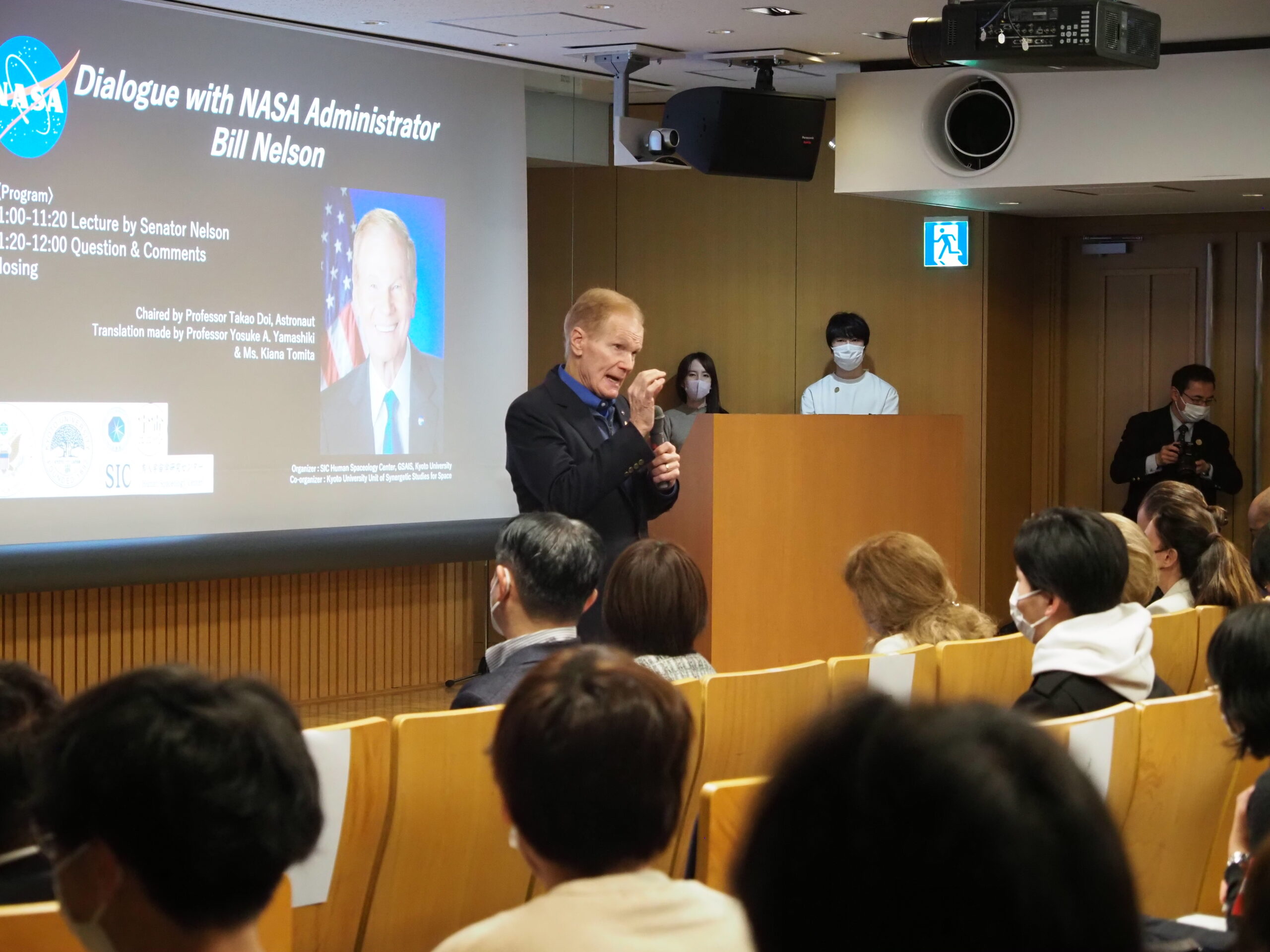
OLYMPUS DIGITAL CAMERA
I am surprised the press hasn’t asked me about the Chinese balloon. Hey, you guys from the press are really tame.
中国の風船について報道陣から質問されないのが不思議です。報道陣の皆さんは本当に手加減してくれますね。
Q: I love NASA. Actually, I am working in a private company and working with space telecommunication. And am interested in working with Apple for sustainable and life-supporting and environmental systems in space. What do you expect for the venture and what part do you think of the Human Spaceology center is important for the life supporting systems? And also the business chance, because I want to raise about the life supporting systems for the future.
私はNASAが大好きです。私は民間企業で、宇宙通信の仕事をしています。そして、アップルと一緒に宇宙での持続可能な生命維持・環境システムの実現に興味があります。ベンチャーに期待することは何ですか?また、生命維持システムにとって、Human Spaceology Centerのどの部分が重要だと思われますか?私は将来の生命維持装置について考えたいようですので、ビジネスチャンスもあると思います。
(Nelson長官)
What is the value of the private sector?
Yamashiki-sensei:
He is now working for that company.
(Nelson長官)
If you are working in a company that is telecommunications, we have to communicate. If it’s a robotic spacecraft, we have to communicate, if it’s a human endeavor, we have to communicate. We are communicating with the James Webb space telescope from time to time on our deep space network and sometimes that gets in conflict with our need to use the deep space network to communicate with the Perseverance rover on the surface of Mars and the Ingenuity Helicopter. So we are developing a new system of communication with lasers so that it will be faster and more abundant in order to be able to communicate with whatever the spacecraft is. So it is a very prominent part of our future space program.
もし宇宙通信の会社に勤めているならば、宇宙通信をそのまま続けてください。ロボットの宇宙船であれば交信しなければならないし、人間も同様に通信しなければなりません。ジェームスウエッブ宇宙望遠鏡と同様、火星探査機「パーセバランス」やヘリコプター「インジェニュイティ」と通信するために、深宇宙ネットワークを使用する必要があるのですが、その際に通信チャンネルが混線することがあります。そこで私たちは、レーザーによる新しい通信システムを開発し、より速く、より多くの宇宙船と通信できるようにしています。このように、レーザー通信技術は私たちの将来の宇宙開発において、非常に重要な役割を担っているのです。
(後半 通訳 冨田キアナ)
Q:
Thank you for your great presentation. My name is Hina Bando, and my major is planetary science in Kyoto University, especially in Martian atmosphere. My question is, I think it’s still possible to explore another life on Mars with unmanned systems, but what do you think it means for people to go to Mars and create new societies, with human systems?
素晴らしいプレゼンテーションをありがとうございました。私は坂東日菜といい、京都大学で地球惑星科学専攻で、特に火星大気について研究しています。質問ですが、火星での生命探査は無人でも可能だと思いますが、人間が火星に行き、人間のシステムで新しい社会を作るというのはどういうことだと思いますか?
(Nelson長官)
The question is, what does it mean to us to develop a human society on Mars?
I don’t know.
I don’t know, do we need to send a part of our civilization to another celestial body in order to keep our species continuing? Are we going to blow ourselves up on Earth that we would need to send out colonizers to other worlds? I don’t know, but I want to know how to get there if there is a reason to go. Maybe we will have space colonies in space that are not on a celestial body. Jeff Bezos has a concept of these floating, out in space, colonies that are advanced cities that are out in the vacuum of space. But they have a contained atmosphere for humans. There are many possibilities.
質問ですが、火星で人間社会を発展させることは、私たちにとってどんな意味があるのでしょうか?ということですね
実の所私にもわかりません。
人類という種を絶やさないために、文明の一部を他の天体に送る必要があるのでしょうか?地球が人口爆発して、他の星に植民者を送り出す必要があるのか?わからないけど、行く理由があるのなら、どうやって行くのか知りたいとおもっています。もしかしたら、天体上ではない宇宙空間に、スペースコロニーができるかもしれません。ジェフ・ベゾスの構想では、宇宙に浮かぶスペースコロニーは、真空の宇宙にある非常に高度な都市です。しかし、そこには人間のための大気圏がつくられ、非常に大きな可能性があります。
(Nelson長官)
So, I’m presenting, a picture of the first Artemis mission. And this is the spacecraft Orion, and it is a human-rated spacecraft. And it is at its fartherest point from Earth. It’s 270,000 miles from Earth. And when you look at the photograph up close, so you can see, you will see in the foreground is the moon, which it’s is 40,000 miles from the moon.
And in the background is the beautiful blue marble planet Earth and it’s 270,000 miles from Earth. This is where we’re going with humans.
最初のアルテミスミッションの写真を(土井先生に)お渡しします これはオリオン宇宙船で、人間が搭乗する宇宙船です。地球から最も遠い場所にあります。地球から27万マイルのところにあります。この写真を近くで見ると、手前に見えるのは月で、月からは4万マイル離れています。
そして背景は美しい青い大理石の惑星、地球で、地球から27万マイル離れています。これが私たち人類が目指すところです。


